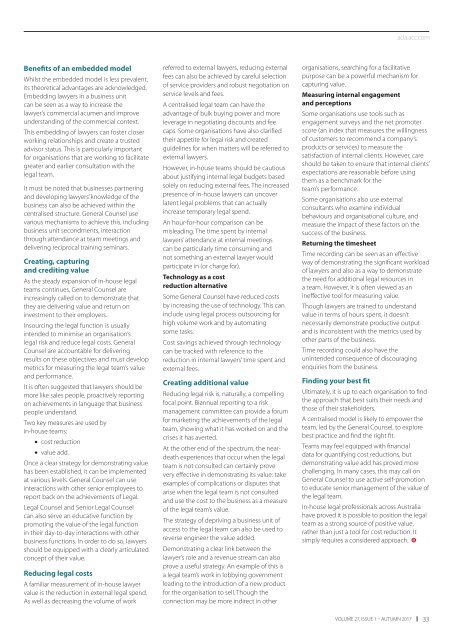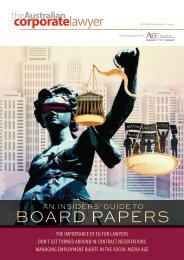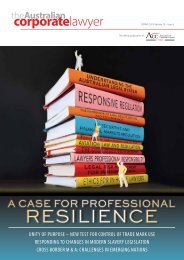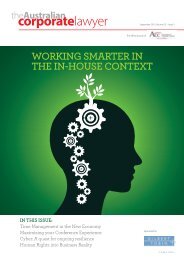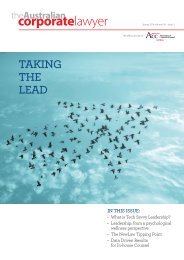Australian Corporate Lawyer - Autumn 2017
Australian Corporate Lawyer is the official publication of the Association of Corporate Counsel (ACC) Australia. The Autumn 2018 issue focuses on 'The Law and Technology' and features a range of articles covering topics including: the future of contracts and; the future of law firms as software companies..
Australian Corporate Lawyer is the official publication of the Association of Corporate Counsel (ACC) Australia. The Autumn 2018 issue focuses on 'The Law and Technology' and features a range of articles covering topics including: the future of contracts and; the future of law firms as software companies..
You also want an ePaper? Increase the reach of your titles
YUMPU automatically turns print PDFs into web optimized ePapers that Google loves.
acla.acc.com<br />
Benefits of an embedded model<br />
Whilst the embedded model is less prevalent,<br />
its theoretical advantages are acknowledged.<br />
Embedding lawyers in a business unit<br />
can be seen as a way to increase the<br />
lawyer’s commercial acumen and improve<br />
understanding of the commercial context.<br />
This embedding of lawyers can foster closer<br />
working relationships and create a trusted<br />
advisor status. This is particularly important<br />
for organisations that are working to facilitate<br />
greater and earlier consultation with the<br />
legal team.<br />
It must be noted that businesses partnering<br />
and developing lawyers’ knowledge of the<br />
business can also be achieved within the<br />
centralised structure. General Counsel use<br />
various mechanisms to achieve this, including<br />
business unit secondments, interaction<br />
through attendance at team meetings and<br />
delivering reciprocal training seminars.<br />
Creating, capturing<br />
and crediting value<br />
As the steady expansion of in-house legal<br />
teams continues, General Counsel are<br />
increasingly called on to demonstrate that<br />
they are delivering value and return on<br />
investment to their employers.<br />
Insourcing the legal function is usually<br />
intended to minimise an organisation’s<br />
legal risk and reduce legal costs. General<br />
Counsel are accountable for delivering<br />
results on these objectives and must develop<br />
metrics for measuring the legal team’s value<br />
and performance.<br />
It is often suggested that lawyers should be<br />
more like sales people, proactively reporting<br />
on achievements in language that business<br />
people understand.<br />
Two key measures are used by<br />
in-house teams:<br />
• cost reduction<br />
• value add.<br />
Once a clear strategy for demonstrating value<br />
has been established, it can be implemented<br />
at various levels. General Counsel can use<br />
interactions with other senior employees to<br />
report back on the achievements of Legal.<br />
Legal Counsel and Senior Legal Counsel<br />
can also serve an educative function by<br />
promoting the value of the legal function<br />
in their day-to-day interactions with other<br />
business functions. In order to do so, lawyers<br />
should be equipped with a clearly articulated<br />
concept of their value.<br />
Reducing legal costs<br />
A familiar measurement of in-house lawyer<br />
value is the reduction in external legal spend.<br />
As well as decreasing the volume of work<br />
referred to external lawyers, reducing external<br />
fees can also be achieved by careful selection<br />
of service providers and robust negotiation on<br />
service levels and fees.<br />
A centralised legal team can have the<br />
advantage of bulk buying power and more<br />
leverage in negotiating discounts and fee<br />
caps. Some organisations have also clarified<br />
their appetite for legal risk and created<br />
guidelines for when matters will be referred to<br />
external lawyers.<br />
However, in-house teams should be cautious<br />
about justifying internal legal budgets based<br />
solely on reducing external fees. The increased<br />
presence of in-house lawyers can uncover<br />
latent legal problems that can actually<br />
increase temporary legal spend.<br />
An hour-for-hour comparison can be<br />
misleading. The time spent by internal<br />
lawyers’ attendance at internal meetings<br />
can be particularly time consuming and<br />
not something an external lawyer would<br />
participate in (or charge for).<br />
Technology as a cost<br />
reduction alternative<br />
Some General Counsel have reduced costs<br />
by increasing the use of technology. This can<br />
include using legal process outsourcing for<br />
high volume work and by automating<br />
some tasks.<br />
Cost savings achieved through technology<br />
can be tracked with reference to the<br />
reduction in internal lawyers’ time spent and<br />
external fees.<br />
Creating additional value<br />
Reducing legal risk is, naturally, a compelling<br />
focal point. Biannual reporting to a risk<br />
management committee can provide a forum<br />
for marketing the achievements of the legal<br />
team, showing what it has worked on and the<br />
crises it has averted.<br />
At the other end of the spectrum, the neardeath<br />
experiences that occur when the legal<br />
team is not consulted can certainly prove<br />
very effective in demonstrating its value: take<br />
examples of complications or disputes that<br />
arise when the legal team is not consulted<br />
and use the cost to the business as a measure<br />
of the legal team’s value.<br />
The strategy of depriving a business unit of<br />
access to the legal team can also be used to<br />
reverse engineer the value added.<br />
Demonstrating a clear link between the<br />
lawyer’s role and a revenue stream can also<br />
prove a useful strategy. An example of this is<br />
a legal team’s work in lobbying government<br />
leading to the introduction of a new product<br />
for the organisation to sell. Though the<br />
connection may be more indirect in other<br />
organisations, searching for a facilitative<br />
purpose can be a powerful mechanism for<br />
capturing value.<br />
Measuring internal engagement<br />
and perceptions<br />
Some organisations use tools such as<br />
engagement surveys and the net promoter<br />
score (an index that measures the willingness<br />
of customers to recommend a company’s<br />
products or services) to measure the<br />
satisfaction of internal clients. However, care<br />
should be taken to ensure that internal clients’<br />
expectations are reasonable before using<br />
them as a benchmark for the<br />
team’s performance.<br />
Some organisations also use external<br />
consultants who examine individual<br />
behaviours and organisational culture, and<br />
measure the impact of these factors on the<br />
success of the business.<br />
Returning the timesheet<br />
Time recording can be seen as an effective<br />
way of demonstrating the significant workload<br />
of lawyers and also as a way to demonstrate<br />
the need for additional legal resources in<br />
a team. However, it is often viewed as an<br />
ineffective tool for measuring value.<br />
Though lawyers are trained to understand<br />
value in terms of hours spent, it doesn’t<br />
necessarily demonstrate productive output<br />
and is inconsistent with the metrics used by<br />
other parts of the business.<br />
Time recording could also have the<br />
unintended consequence of discouraging<br />
enquiries from the business.<br />
Finding your best fit<br />
Ultimately, it is up to each organisation to find<br />
the approach that best suits their needs and<br />
those of their stakeholders.<br />
A centralised model is likely to empower the<br />
team, led by the General Counsel, to explore<br />
best practice and find the right fit.<br />
Teams may feel equipped with financial<br />
data for quantifying cost reductions, but<br />
demonstrating value add has proved more<br />
challenging. In many cases, this may call on<br />
General Counsel to use active self-promotion<br />
to educate senior management of the value of<br />
the legal team.<br />
In-house legal professionals across Australia<br />
have proved it is possible to position the legal<br />
team as a strong source of positive value,<br />
rather than just a tool for cost reduction. It<br />
simply requires a considered approach.<br />
VOLUME 27, ISSUE 1 – AUTUMN <strong>2017</strong><br />
33


